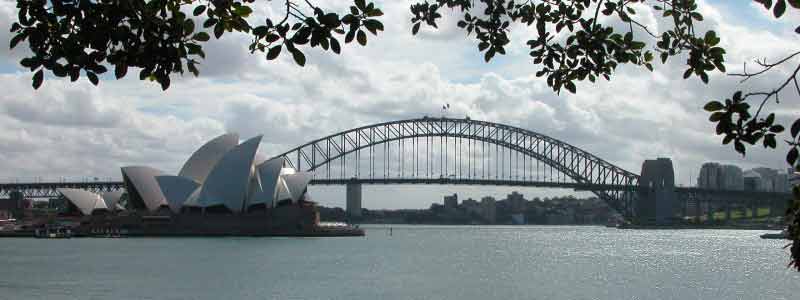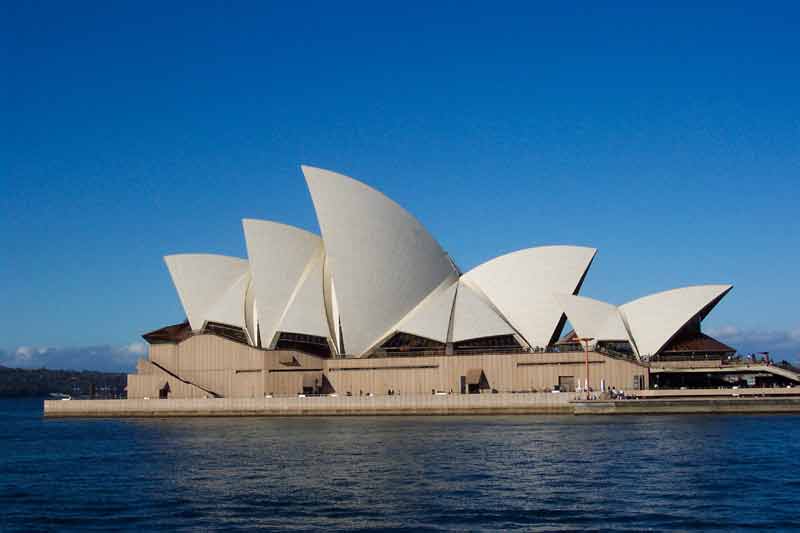 |
usa | world | animals | vocabulary | health | science | math | history |
Sydney Opera House
The Sydney Opera House in Sydney, New South Wales, Australia, is one of the most distinctive and famous 20th-century buildings, and one of the most famous performing arts venues in the world. Situated on Bennelong Point in Sydney Harbour, with parkland to its south and close to the enormous Sydney Harbour Bridge, the building and its surroundings form an iconic Australian image. To some the spherical-sectioned shells remind them of the flotilla of sailboats commonly cruising there. Tourists, most with no interest in opera, throng to the building in their thousands purely to see it.
As well as many touring theatre, ballet, and musical productions the Opera House is the home of Opera Australia, the Sydney Theatre Company and the Sydney Symphony Orchestra. It is administered by the Opera House Trust, under the New South Wales (NSW) Ministry of the Arts.
The Opera House provides 45,000 square metres (11 acres) of usable office space out of 18,000 square metres (4.5 acres) of land. It is 183 metres (600 feet) tall and about 120 metres (388 feet) wide at its widest point. It is supported on 580 concrete piers sunk up to 25 metres below sea level. Its power supply is equivalent for a town of 25,000 people. The power is distributed by 645 kilometres of electrical cable. It has about 1000 rooms. It has five theatres, five rehearsal studios, two main halls, four restaurants, six bars and numerous souvenir shops.
The opera house's roof is constructed of 1,056,000 glazed white granite tiles imported from Sweden. Despite their self-cleaning nature, they are still subject to maintenance and replacement. Its interior is composed of pink granite mined from Tarana, NSW and white birch and brush box plywood supplied from northern NSW.

Its five theatres are the Concert Hall (with a seating capacity of 2679), Opera Theatre (1547 seats), Drama Theatre (544 seats), Playhouse (398 seats) and Studio Theatre (364 seats).
The Concert Hall contains the Sydney Opera House Grand Organ. It is the largest mechanical tracker action organ in the world with over 10,000 pipes.
The theatres are contained in a series of large shells, modelled by dissecting a globe. The Concert Hall and Opera Theatre are contained in the largest shells, and the other theatres are located on the sides of the shells. Large free public performances have also often been staged in front of the Monumental Steps that lead up to the base of the main sets of shells. A much smaller set of shells set to one side of the Monumental steps houses one of the formal dining restaurants.
The Bennelong Point Tram Depot, present on the site at the time, was demolished in 1958, and formal construction of the Opera House began in March, 1959. The project was built in three stages. Stage I (1959-1963) consisted of building the upper podium. Stage II (1963-1967) was the construction of the outer shells. Stage III consisted of the interior design and construction (1967-73).
Stage I was called for tender on December 5, 1958, and worked commenced on the podium on May 5, 1959 by the firm of Civil & Civic. The government had pushed for work to begin so early because they were afraid funding, or public opinion, might turn against them. However major structural issues still plagued the design (most notably the sails, which were still parabolic at the time).
By January 23, 1961, work was running 47 weeks behind, mainly due to unexpected difficulties (wet weather, unexpected difficulty diverting stormwater, construction beginning before proper engineering drawings had been prepared, changes of original contract documents). Work on the podium was finally completed on August 31, 1962.
Stage II, the shells were a originally designed as a series of parabolas, however engineers Ove Arup and partners had not been able to find an acceptable solution to constructing them. In mid 1961 Utzon handed the engineers his solution to the problem, the shells all being created as ribs from a sphere of the same radius. This not only satisfied the engineers, and cut down the project time drastically from what it could have been (it also allowed the roof tiles to be prefabricated in sheets on the ground, instead of being stuck on individually in mid-air), but also created the wonderful shapes so instantly recognisable today. Ove Arup and partners supervised the construction of the shells, estimating on April 6, 1962 that it would be completed between August 1964, and March 1965. By the end of 1965, the estimated finish for stage II was July 1967.
Stage III, the interiors, started with Utzon moving his entire office to Sydney in February 1963. However, there was a change of government in 1965, and the new Askin government declared that the project was now under the jurisdiction of the Ministry of Public Works. In October 1965, Utzon gave the Minister for Public Works, Davis Hughes, a schedule setting out the completion dates of parts of his work for stage III. Significantly, Hughes withheld permission for the construction of plywood prototypes for the interiors (Utzon was at this time working closely with Ralph Symonds, an inventive and progressive manufacturer of plywood, based in Sydney). This eventually forced Utzon to leave the project on February 28th, 1966. He said that Hughes'es refusal to pay Utzon any fees and the lack of collaboration caused his resignation, and later famously described the situation as "Malice in Blunderland". In March 1966, Hughes offered him a reduced role as 'design architect', under a panel of executive architects, without any supervisory powers over the House's construction but Utzon rejected this. The cost of the project, even in October of that year, was still only $22.9 million, less than a quarter of the final cost.

The second stage of construction was still in process when Utzon was forced to resign. His postion was largely taken over by Peter Hall, who became largely responsible for the interior design. Other persons appointed that same year to replace Utzon were E.H.Farmer as government architect, D.S.Littlemore and Lionel Todd.
The four significant changes to the design since Utzon left were:
The cladding to the podium and the paving (the podium was originally not to be clad down to the water, but left open. Also the paving chosen was different from what Utzon would have chosen)
The construction of the glass walls (Utzon was planning to use a system of prefabricated plywood mullions, and although eventually a quite inventive system was created to deal with the glass, it is different from Utzon's design)
Use of the halls (The major hall which was originally to be a multipurpose opera/concert hall, became solely a concert hall. The minor hall, originally for stage productions only, had the added function of opera to deal with. Two more theatres were also added. This completely changed the layout of the interiors, where the stage machinery, already designed and fitted inside the major hall, was pulled out and largely thrown away)
The interior designs (Utzon's plywood corridoor designs, and his acoustic and seating designs for the interior of both halls, were scrapped completely.)
The opera house was formally completed in 1973, to a bill of $102 million. The original cost estimate in 1957, was £3,500,000 ($7 million). The original completion date set by the government was January 26, 1963.
The Opera House was formally opened by Queen Elizabeth II on October 20, 1973. The opening was televised and included fireworks and a performance of Beethoven's Symphony No. 9.
Prior to the opening, two performances had already taken place there. On September 28, 1973, a performance of Sergei Prokofiev's War and Peace was played at the Opera Theatre. On September 29, the first public concert in the Concert Hall took place. It was performed by the Sydney Symphony Orchestra, conducted by Charles Mackerras and with accompanying singer Birgit Nilsson.
It has been subject to some additions and improvements since its opening. The pipe organ in the Concert Hall was not completed until 1979. In 1988, a two-level walkway along the western side of Bennelong Point was added as part of Australia's bicentenary celebrations. In 1999, a fifth theatre, the Playhouse, was added to the Opera House.
In 1997, French urban climber, Alain "Spiderman" Robert, using only his bare hands and feet and with no safety devices of any kind, scaled the building's exterior wall all the way to the top.
It received attention during Sydney 2000 Olympics. It was included in the Olympic Torch route to the Olympic stadium, and involved Australian swimmer Samantha Riley standing on top of the Opera House waving the Olympic torch. It was the backdrop of some Olympic events, including the triathlon—which began at the Opera House—and the yachting events on Sydney Harbour.
Security at the Opera House has increased as the result of the likelihood of it attracting attention of terrorists because the Australian Government's support of the invasion of Iraq. This security did not prevent two climbers painting a "No War" slogan at the top of one sail in March 2003. The repair bill for this was later revealed to be over $100,000.
Following an arrangement made in 1999, plans were made to change Hall's internal design of the Opera House to that of Utzon's. The redesign involves the house's reception hall and opera theatre, and will be supervised by Utzon. As Utzon is too old to travel by plane, he undertakes the supervision from his home in Majorca. Allowances will be made for modern day technology and requirements. In September 2004, the redesign of the Reception Hall of the opera house was completed, but is now only rarely available for public inspection.
This article is licensed under the GNU Free Documentation License. It uses material from the Wikipedia article "Sydney".